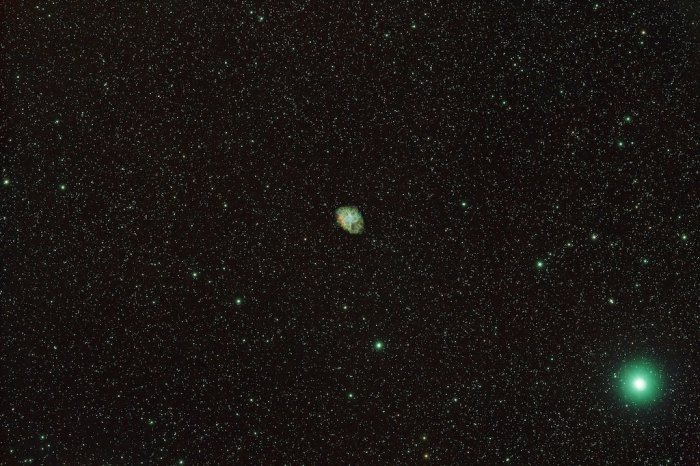ScienceDownEast | ScienceDownEast Astrophotography | Nebulae | M1 Crab Nebula | M1 Crab Nebula
M1 (also known as the Crab Nebula) From Wikipedia -> The Crab Nebula is a supernova remnant and pulsar wind nebula in the constellation of Taurus. The common name comes from a drawing that somewhat resembled a crab with arms produced by William Parsons, 3rd Earl of Rosse, in 1842 or 1843 using a 36-inch (91 cm) telescope. The nebula was discovered by English astronomer John Bevis in 1731. It corresponds with a bright supernova recorded by Chinese astronomers in 1054 as a guest star. The nebula was the first astronomical object identified that corresponds with a historically-observed supernova explosion.
At an apparent magnitude of 8.4, comparable to that of Saturn's moon Titan, it is not visible to the naked eye but can be made out using binoculars under favourable conditions. The nebula lies in the Perseus Arm of the Milky Way galaxy, at a distance of about 2.0 kiloparsecs (6,500 ly) from Earth. It has a diameter of 3.4 parsecs (11 ly), corresponding to an apparent diameter of some 7 arcminutes, and is expanding at a rate of about 1,500 kilometres per second (930 mi/s), or 0.5% of the speed of light.
At the center of the nebula lies the Crab Pulsar, a neutron star 28–30 kilometres (17–19 mi) across with a spin rate of 30.2 times per second, which emits pulses of radiation from gamma rays to radio waves. At X-ray and gamma ray energies above 30 keV, the Crab Nebula is generally the brightest persistent gamma-ray source in the sky, with measured flux extending to above 10 TeV. The nebula's radiation allows detailed study of celestial bodies that occult it. In the 1950s and 1960s, the Sun's corona was mapped from observations of the Crab Nebula's radio waves passing through it, and in 2003, the thickness of the atmosphere of Saturn's moon Titan was measured as it blocked out X-rays from the nebula. .
Note: click on the image to view it at the full resolution of the uploaded image, then click again for actual size.
| Exposure | 10@1200 sec (3.3 hours) | ||||||||
| ISO | 3200 | ||||||||
| Camera | Nikon Z7 [8856 x 5504] | ||||||||
| Optics | Skywatcher Esprit 120mm Refractor, 840 mm focal length | ||||||||
| Filter | Radian Triad Ultra Quad-Band Narrowband Filter | ||||||||
| Guiding | Phd2 using a ZWO 224MC on an Orion 60x240mm Guide scope | ||||||||
| Controller | Images taken using Kstars on an Mele Quieter 3C under Unbuntu 22.04.3 | ||||||||
| Location | Lower Sackville, Nova Scotia. | ||||||||
| Date | 2023-12-09 | ||||||||
| PixInsight Processing |
|

